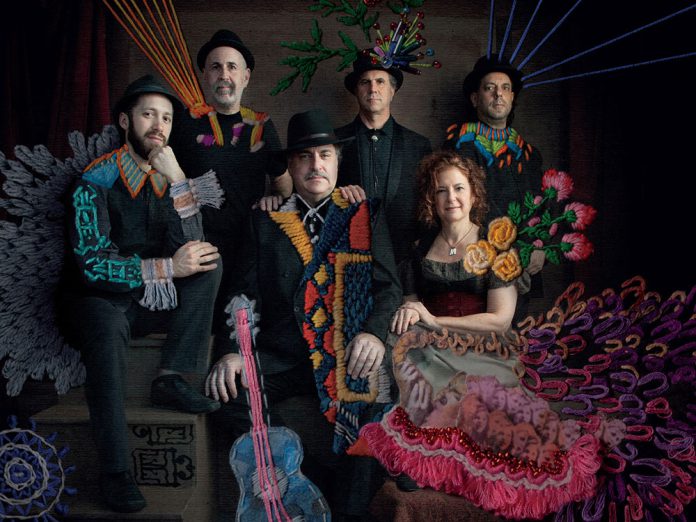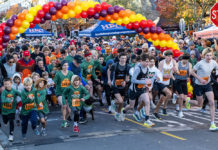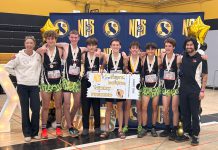
What better way to celebrate the holidays than with Woody Guthrie’s Hanukkah music? Healdsburg did exactly that a year ago, and on Dec. 9 the Raven Theater will again host the eclectic, durable group of New York musicians who are keeping the music alive—and recreating it as they go.
Though the sound is steeped in Eastern European influences and instrumentation—accordion, clarinet or flute, bass, violin and percussion, along with several more unfamiliar ethnic instruments—Klezmer finds its roots in Jewish party music.
The Klezmatics bill themselves as, among other things, the only Grammy-winning Klezmer band, for Best Contemporary World Music for their recording, Wonder Wheel (2006). That unusual recording included a collaboration between the New York-based overtly Jewish band and folk-icon Woody Guthrie.

“Woody’s wife was Jewish,” said Lisa Gutkin, violinist for the Klezmatics. “And her mother was a Yiddish poet and songwriter, Elisa Greenblatt. Woody had a beautiful connection with her and he wrote Hanukkah songs.”
That would make it the late 1940s, when Guthrie was married to Marjorie Greenblatt. Among their four children was Arlo Guthrie, and though the couple divorced in 1953, it was Marjorie who remained by the fading singer/songwriter’s side in his final years and supervised his health needs as he deteriorated due to Huntington’s disease.
The group’s follow-up CD, Woody Guthrie’s Happy Joyous Hanukkah (2009), takes a deeper dive into the traditional sound, again featuring Guthrie’s lyrics as an inspirational springboard. The essential elements of the Klezmer tradition include dance tunes, ritual melodies and virtuosic improvisations played for listening.
The word “Klezmer” comes from two Yiddish words, kley and zemer, meaning “instrument of song.” The name originally referred to the instruments themselves, then later to the men who played them. Topo, in Fiddler on the Roof, was a Klezmer musician, “schlepping his way from shtetl to shtetl… a distinctive image of pre-war Jewish life in the Ashkenazi communities of Eastern Europe,” according to worldmusic.net.
Ironically, Klezmer music as a genre is only a little older than the group the Klezmatics. “Originally the word Klezmer didn’t exist; it was just Jewish wedding music,” Gutkin said. “It is an old word, but to use it as a genre was kind of invented in the ’70s. They just needed a marketing term, basically.”
Hearing the Klezmatics, however, is not a history lesson, except in the best sense—making not just the past come alive, but also a generations-old legacy of faith, community and family. While the instruments and melodics are essential to the style, for the Klezmatics, vocal performance is huge.
“Every band has their own take on combining the tradition with their own experiences in life,” Gutkin said. “There’s very few Klezmer musicians who grew up with it and experienced it the way it was played a hundred years ago. We’re all kind of reinventing the genre.
“For the Klezmatics, it’s very important to sing about social justice and sing about the human condition,” she continued. “And of course, when you do that, you are going to hit the highs, the lows, the dramatic, the funny, every aspect of life. There’s some drama to be sung about these days, and we do it. That’s become a very important part of our music on an emotional level.”
In performance nearly all of the musicians take a turn singing, including Gutkin. But the star vocalist is the group’s co-founder, Lorin Sklamberg. His show-stopping voice is powerful and compelling, adding a transcendent dimension to the folk layer of Klezmer.
The other co-founder was Frank London, who plays trumpet and keyboards. The two founded the group in 1986, but even the newest member, percussionist Richie Barshay (of the Herbie Hancock Quartet), has been with the Klezmatics for over a dozen years. Paul Morrissett, bassist and tsimbl player (similar to a hammered dulcimer) came on in the group’s first year, and multi-instrumentalist Matt Darriau has infused the Klezmatics’ sound with jazz, Balkan and Celtic influences since 1995. After years as a “sub,” Gutkin joined for good in the early 2000s.
A remaster of their influential Woody Guthrie’s Happy Joyous Hanukkah was just released on Nov. 14, 2025, and tracks added.
“It’s a performative style,” Gutkin said. “Really when you are playing, you are intentionally wanting to trigger somebody’s desire to dance. That’s part of our ethos for sure.”
Last year’s concert did indeed trigger that desire, as a few people got up in front of the stage; Raven Executive Director Tom Brand hopes to see the same this year, and promises the open areas in front of both the left and right aisles will be clear for dancing.
The Klezmatics will perform at the Raven Theater on Tuesday, Dec. 9. Doors open at 6:30pm, concert begins at 7:30pm. Admission is $34-$54 including fees.








